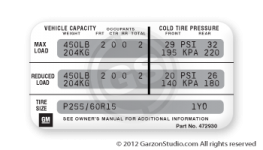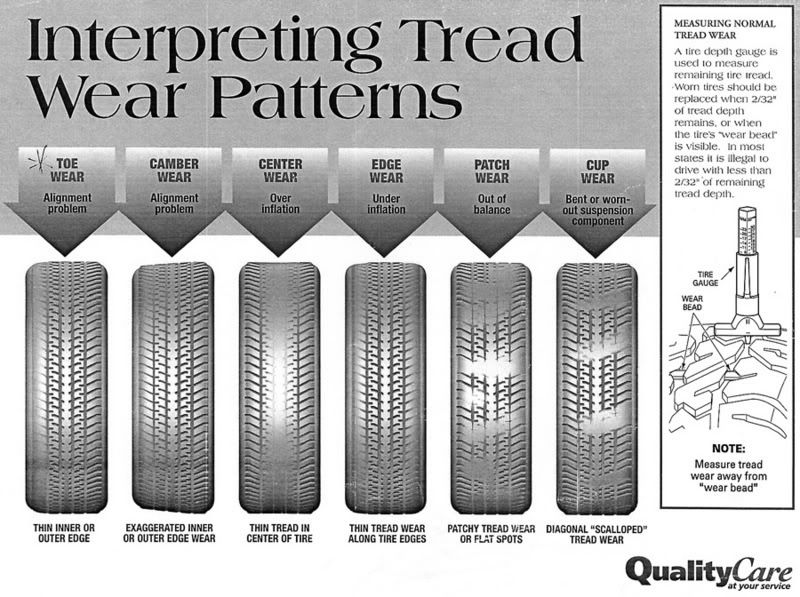toobroketoretire
Banned
Knowing this will almost certainly freak most of you out I'll go ahead and tell you what I run in my small block '82 and big block '71. Are you sitting down? In my small block '82 I run 20 psi front/17 psi rear and have done so for 25 years. And in my big block '71 I run 24 psi front/17 psi rear and have done so since I bought it in 2009. With those low (and correct) pressures I get 50,000+ miles out of my tires with perfectly even tread wear. As my '71 is my daily driver it gets driven about 25,000+ miles per year so it's due for a set of new tires every two years. Since I bought my '82 in 1988 I have put about 12 sets of tires on it and since 2009 I have put 3 sets of tires on my '71.
You are certainly thinking those pressures are way too low and unsafe but I'll explain why those are the correct pressures for a C3: Prior to the advent of the modern low profile/high pressure tires that began showing up in the mid '80's the mid 70's thru early '80's Corvettes, Camaros, Chevelles, Novas, GTO's, Firebirds, Skylarks, 442's, and such ran huge high profile/low pressure 225 thru 255X60R15 tires that had internal volumes that were twice as big as the modern low profile tires. The huge 225 thru 255X60R15's have a load rating of 1875 pounds @ 35 psi per tire but when mounted on these lighter 3500 pound cars the tires only required half the pressure to support half the maximum 7500 pound load. Meaning the huge 225 thru 255X60R15's were way bigger than needed for the lighter loads they were supporting. Fine and dandy but as the 3000 mile oil change intervals increased over the years to 5000 to 7500 to 10,000 to 12,000 to 15,000 miles the dealers who serviced these cars only saw them once in a GREAT while (often a year or more) so a slow leak could result in a dangerously low pressure by the time the car was finally brought to the dealer for servicing. So the lower 20 psi/17 psi was perfectly safe as long as those lower pressures were maintained................which very few people did because the average owner doesn't have an air compressor and self-service gas stations often didn't have one either; leaving it up to the dealers to check them maybe once per year. So by 1982 the "big three" manufacturers were forced to recommend MAXIMUM pressures to cover their lawsuit-weary butts.
The really nice thing about running the lower pressures is your C3 car will ride real smooth. And no, the tire will not come off the rim during hard cornering because 20 psi is more than enough to maintain tire-to-rim contact even in a high speed full broad slide on asphalt. If I were going to road race my C3's on paved tracks or run them at the Bonneville salt flats I would definitely pump them up to 30+ psi. But for every day street use the lower pressures are perfectly safe AS LONG AS those lower pressures are maintained.
Comments?
You are certainly thinking those pressures are way too low and unsafe but I'll explain why those are the correct pressures for a C3: Prior to the advent of the modern low profile/high pressure tires that began showing up in the mid '80's the mid 70's thru early '80's Corvettes, Camaros, Chevelles, Novas, GTO's, Firebirds, Skylarks, 442's, and such ran huge high profile/low pressure 225 thru 255X60R15 tires that had internal volumes that were twice as big as the modern low profile tires. The huge 225 thru 255X60R15's have a load rating of 1875 pounds @ 35 psi per tire but when mounted on these lighter 3500 pound cars the tires only required half the pressure to support half the maximum 7500 pound load. Meaning the huge 225 thru 255X60R15's were way bigger than needed for the lighter loads they were supporting. Fine and dandy but as the 3000 mile oil change intervals increased over the years to 5000 to 7500 to 10,000 to 12,000 to 15,000 miles the dealers who serviced these cars only saw them once in a GREAT while (often a year or more) so a slow leak could result in a dangerously low pressure by the time the car was finally brought to the dealer for servicing. So the lower 20 psi/17 psi was perfectly safe as long as those lower pressures were maintained................which very few people did because the average owner doesn't have an air compressor and self-service gas stations often didn't have one either; leaving it up to the dealers to check them maybe once per year. So by 1982 the "big three" manufacturers were forced to recommend MAXIMUM pressures to cover their lawsuit-weary butts.
The really nice thing about running the lower pressures is your C3 car will ride real smooth. And no, the tire will not come off the rim during hard cornering because 20 psi is more than enough to maintain tire-to-rim contact even in a high speed full broad slide on asphalt. If I were going to road race my C3's on paved tracks or run them at the Bonneville salt flats I would definitely pump them up to 30+ psi. But for every day street use the lower pressures are perfectly safe AS LONG AS those lower pressures are maintained.
Comments?






